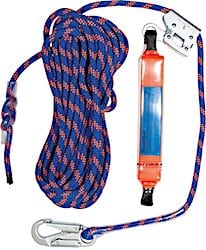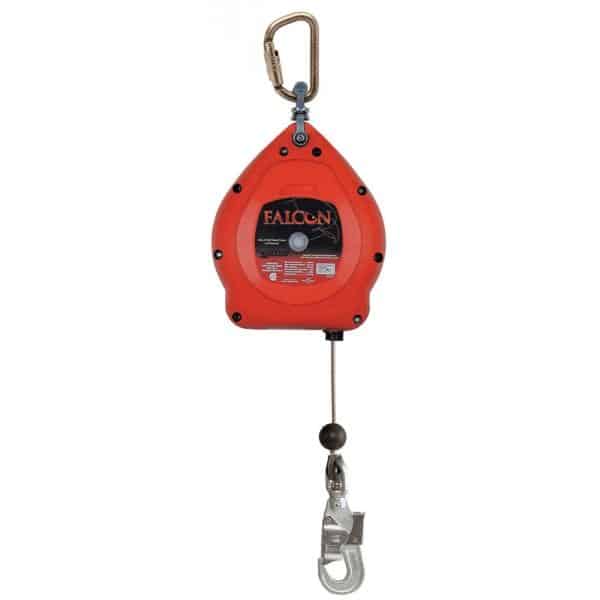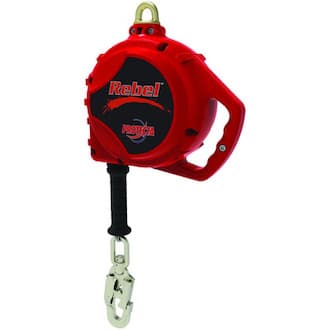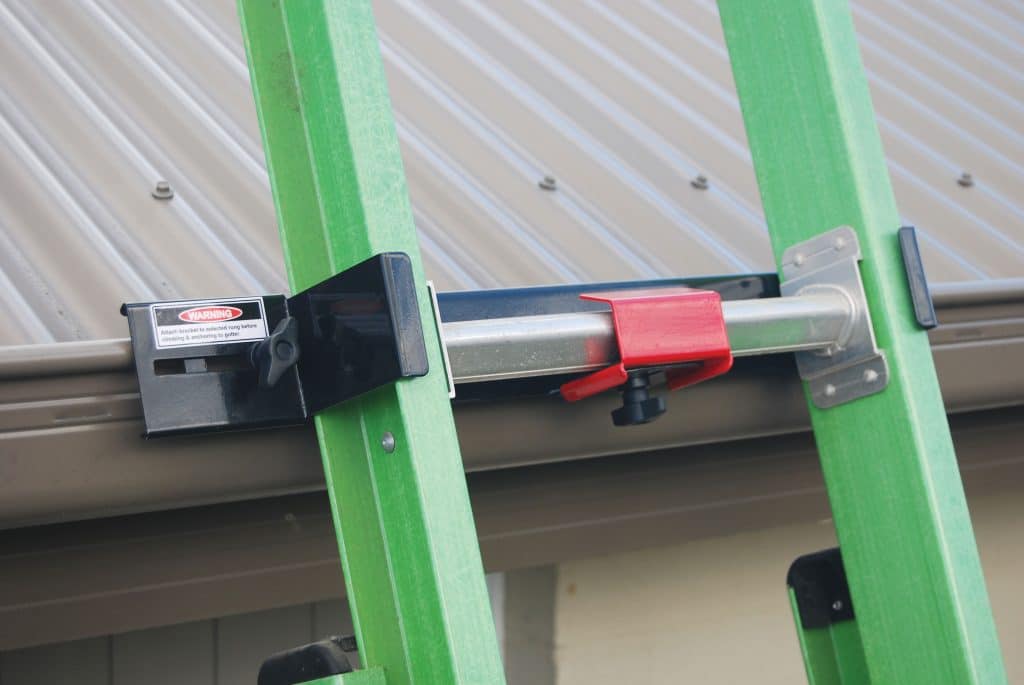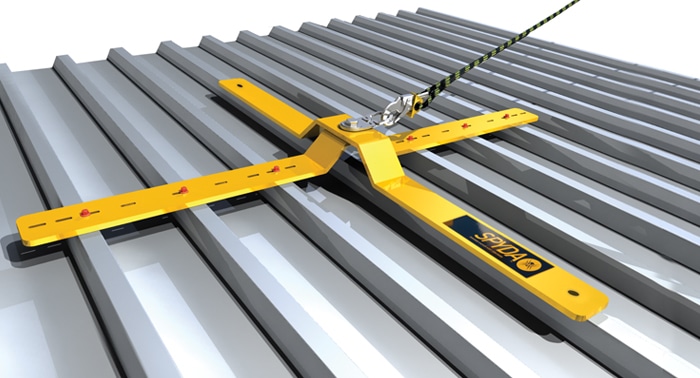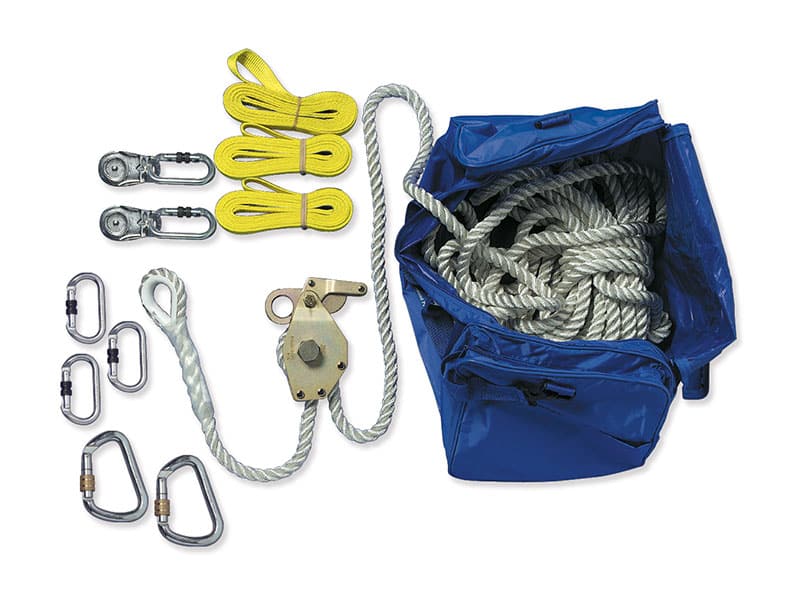The following description of a rescue should not be considered training. A rescue person must have successfully completed a formal rescue course delivered by a professional height safety trainer and have participated in an actual rescue as part of their training.
RESCUE DEMONSTRATION
A person has fallen over the edge of a roof while attached to a roof anchor point via an adjustable rope line. The rescue device being used in this description is the Miller SafEsape. This rescue device and rescue procedure you are about to read can be used for rescuing a suspended worker regardless of the type of system they are attached to. This includes rescue when a person is suspended from:
- Anchor points.
- Static line cable systems.
- Rail systems.
- Ladder bracket and strop.
The rescue system should consist of the following:
- The Rescue device.
- Rescue pole.
- Rope protection (can also use the rescue device bag).
- Temporary roof anchor point.
- Rope cutting safety knife.
- Cable cutters (Up to 10mm cable).
- First Aid Kit and,
- Mobile phone.
PRE-START
Prior to commencing work, the supervisor must ensure that all workers understand the risks involved in working in fall arrest and the safe work methods to be used to prevent a fall from occurring. Once everyone has been inducted into the safe work methods they should inspect their height safety equipment and properly fit their roofing harness. When working in fall arrest, it is advised to wear adequate head protection to protect your head from injury during a fall.
It is important that the rescue equipment is set up ready for immediate deployment. This will save vital time in the event of a fall and help to ensure that the rescue person is not exposed to unnecessary risk. The rescue person will also need to determine if they will be able to lower the fallen worker safely to the ground during the rescue or if they will need to lift them back up and onto the roof. It is always advisable where possible to lower the person if it is safe to do so. This will save time and allow emergency services immediate access to the worker. It should be noted that if this is not possible that there should be a second rescue person to assist with the transition of the worker back onto the roof as this can be quite difficult.
RESCUE SYSTEM INSPECTION
Remove the rescue system from the bag and complete an inspection. Rescue systems must be certified every 6 months and inspected each time prior to set up.
There are four areas that must be inspected:
- Ensure the rope is in good condition and without cuts or damage.
- Ensure the karabiners are free from damage and operate correctly.
- Ensure that the winching mechanism is operating and free from damage.
- Ensure that the rescue pole is free from damage.
RESCUE SYSTEM SET UP
The rescue person should not put themselves at risk during the rescue. Therefore it is vital that the rescue person set up their own adjustable rope line in Fixed Fall Restraint prior to the works commencing. Once set up correctly, the rescue person can quickly implement the rescue plan without putting themselves at risk of a fall. To set up their rope line, first attach to the same roof anchor point that will be used for the works, move to the fall edge and set up the rope line so that the rescue person can reach the edge of the roof but cannot fall using the Adjustable Fall Restraint Method. By fixing the rope line length using the figure eight knot, the rescue person will be able to safely reach the edge and execute the rescue without putting themselves at risk of a fall. It is vitally important that the rescuer does not put themselves at risk.
With the rescue persons rope line set up, move back to the anchor and attach the rescue kit to the same anchor points. It is vital that the rescue device is correctly set up and positioned for a rescue. Precious minutes can be lost if this process is not completed. One of the most important points is to ensure that the rope length is correct. As the rescue device hub has a mechanical advantage, it takes time to draw rope through the device. As you can see, this process cannot be rushed, so must be completed prior to anyone commencing work.
Once you reach the fall edge, extend the rope and hang it over the side of the roof by at least one and a half meters.
Once this has been set up, move back to the anchor, disconnect the rescue kit and place it behind the work zone so that it does not create a trip hazard. It is important that all height safety equipment and other tools are not in the way of a rescue.
Be aware that if the works being conducted move locations where the distance between the anchor and the fall edge changes, that this set up process will need to be performed again to ensure the rescuers safety. This will mean setting up all the height safety equipment again. But this is vital to ensure it is in the correct location if it is needed.
COMMENCING WORK
During works where a person is working in fall arrest and exposed to a potential fall, the rescue person must remain in the green zone and cannot leave the work location. They must oversee the works and ensure that the person working in fall arrest is constantly adjusting their rope line correctly to minimise as much as possible the risk of a fall.
HOW TO CONDUCT A RESCUE
An incident has now occurred. A worker has fallen over the edge and is now suspended. It is vital that you do not panic. If there are other workers close by, call out and tell them to contact emergency services by ringing triple zero.
First attach yourself to an anchor that will allow you to reach fallen worker without exposing yourself to a fall. This may mean you need to attach to the same anchor as the fallen worker. Only do so if the anchor appears safe to use. In particular ensure:
- All the anchor fixings are still attached to the roof sheet.
- The roof sheeting has not torn.
- The roof sheeting is still attached to the roof.
- The anchor appears to be solid.
If this is not the case you will need to set up the temporary roof anchor point to connect yourself and the rescue kit. For this demonstration we have deemed the anchor to be safe to use. Move to the edge and call out to the worker. Tell them to deploy their suspension straps if they are able to.
Move back to the anchor and attach the rescue device. Take hold of the rescue pole and rope, and safely move forward to the edge. This should have you in a position where you can see the fall victim but not able to fall yourself. Call out to the fallen worker and tell them that you are about to perform the rescue. Taking hold of the rescue pole, reach down and connect the rescue karabiner to the persons rear D ring and pull directly up in one smooth motion. Place the rope protector under the rope to protect from any sharp edges. Move back away from the edge and back to the rescue device and place the rescue pole with the other height safety equipment. Wind the rescue hub and lift the worker until their weight has been taken off their rope line and it becomes slack. Lock off the rescue line by placing the rope up and around the rope hook and through the rope brake at the back of the rescue kit hub. Ensure that it has locked off correctly and holding the persons full weight. Now disconnect their rope line from the anchor. If you are unable to do this you will need to cut their rope.
If you are rescuing a person attached to a stainless steel strop cable you will need to disconnect them from their shock absorber.
Yell out to the fall victim and tell them that you are about to commence lowering them. Taking the rope in both hands, remove the rope from the rope grab and allow it to start to thread through your hands keeping tension on the rope.
Once the person has been safely lowered to the ground, immediately render first aid until emergency services arrive.
If you need to winch the worker onto the roof, you will need to be aware of the following changes:
- Do not disconnect their rope line or attachment point.
- Have the second rescue person assist with the transition onto the roof.
- Move the fall victim a minimum of 4m away from the edge once rescued.
- Keep them either laying or sitting down






